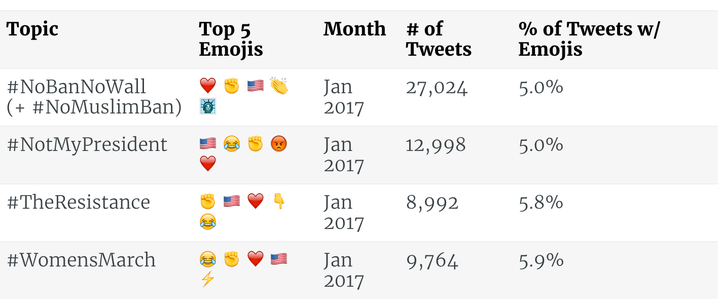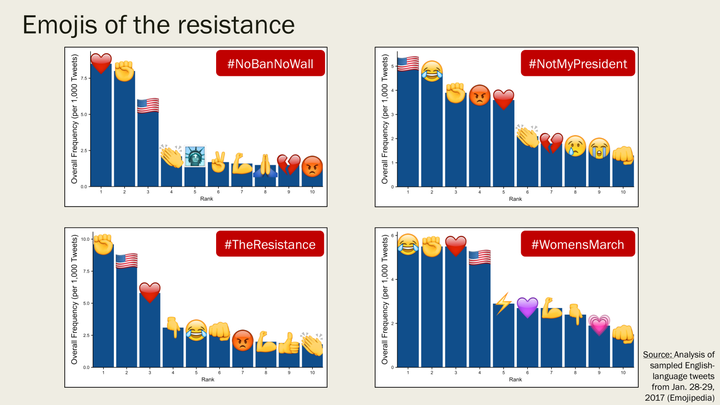
We’ve long used emojis to communicate our feelings when words can’t. But what happens when they take on a deeper meaning, becoming a symbol for an entire movement?
Recently, Hamdan Azhar, founder of data journalism lab Prismoji, decided to explore the use of emojis in viral movements. He analyzed about 60,000 tweets related to hot-button topics like #NoBanNoWall, #NoMuslimBan, #NotMyPresident, #TheResistance, and #WomensMarch to find out which emojis appeared most frequently in those messages.
In a blog post for Emojipedia, Azhar outlined his findings.
The red heart (❤️️ ), tears of joy (😂), the American flag (🇺🇸 ) and the raised fist (✊) were among the most commonly used emojis.
While it’s not surprising that people use the raised fist as an expression of solidarity, Azhar notes that it’s become “a signature emoji of progressive protest.” It even showed up as one of the top five emojis for all of the protest-related hashtags Azhar studied, including #BlackLivesMatter.
And when you consider the appearance of the fist in conjunction with the heart or flag emoji, the research suggests the notion that protesters aren’t patriotic is untrue: These tweeters appear to be coming from a place of love and patriotism.

Amzhar’s research also breaks down how often different emojis are used with the different viral hashtags.
While #NoBanNoWall tweets most often featured emojis representing love and solidarity, many #NotMyPresident tweets included American flags and tearful or angry emojis expressing disappointed patriotism and mockery. (The popular “tears of joy,” for example, could also be read as a tears of ridicule.)
Fists, flags and hearts were popular in #TheResistance tweets, communicating “defiance protest-as-nationalism,” Amzhar said, and the #WomensMarch tweets contained emojis that conveyed a “jumbled mix of mockery, defiance, love, and country, all at once.”

Azhar’s analysis also noted which words are most often used with the ✊ emoji. They include “protesting,” “solidarity” and “together” ― words that communicate “community based humanitarian appeals,” according to Azhar.
Because the analysis focused on tweets that are largely critical of President Donald Trump’s administration, Azhar stressed that Trump supporters may use the ✊ symbol in a different way.
But one thing is certain: We’ve converted a lot of emojis into symbols for the resistance. We can only wonder what new movements they will champion in the next four years.